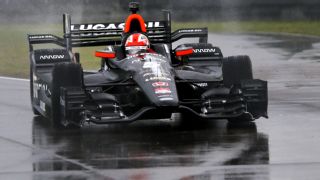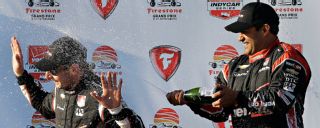|
LONG BEACH, Calif. -- It's hard to get a handle on the state of the 2015 Verizon IndyCar Series after two races, especially when one of them was a washed out weekend at a brand new (and barely finished) circuit. That won't be the case this weekend, as the IndyCar Series descends upon Southern California for the Toyota Grand Prix of Long Beach. It's a familiar venue -- Long Beach has hosted Indy cars every year since 1984 -- and there has never been rain on race day. This year's forecast is perfect, as usual. Yes, after the first round jitters of St. Petersburg and the incessant showers of New Orleans, the tried and true Long Beach Grand Prix should finally give us a good idea what to expect for the rest of the season. But even with a limited amount of information to work with from the races at St. Pete and NOLA Motorsports Park, it's already obvious that we can hold several truths to be self-evident: 1. It's Team Penske's championship to lose. Penske didn't finish 1-2-3-4 at St. Petersburg in its debut as a four-car team, but running 1-2-4-5 with Juan Pablo Montoya, Will Power, Helio Castroneves and Simon Pagenaud wasn't a bad start. The Penske quartet didn't look quite as locked in at NOLA during the only dry practice session, but the rainout of qualifying should have put them in position to dominate the proceedings in the race. Instead, it turned into a typical IndyCar wet race lottery, with Castroneves somehow emerging as the team's top finisher while Montoya, who led most of the race, had to settle for fifth place.  Team Penske currently occupies the top three spots in the standings (Montoya, Castroneves and Power) and that scenario is likely to continue all season. The question is which of the four drivers will win out: Defending series champion Power, perennial championship bridesmaid Castroneves, a rejuvenated Montoya, or new guy Pagenaud? Even if only one team ends up in the battle for the championship, it's bound to remain interesting. 2. Honda has work to do, but may not be that far off. From the start of preseason testing, Chevrolet has held the upper hand over Honda. But the gap isn't as wide as many had first feared, and much of it can be explained by Honda's relative lack of star teams and drivers compared to the Chevrolet lineup. Honda's problems have been magnified by the fact that its flagship team, Andretti Autosport, has been slow to extract the potential from the Honda aero kit. It certainly appears that Honda's current lack of speed is mostly aerodynamic-related, as opposed to its engine being down on power. At St. Petersburg, Ryan Hunter-Reay said that getting down the straights quickly certainly wasn't an issue. And at NOLA, James Hinchcliffe's Honda was able to maintain the lead from a pack of pursuing Chevys over several restarts. Honda Performance Development engineers believe their 2015 cars are not achieving the speed that the computer says they should, so solving the mystery of the new aero components is job No. 1 for Brand H. 3. The new aero kits are a hit. Honda may be having trouble extracting the maximum out of its rakish new wings and wickers, but the introduction of a fresh look that differentiates the basic Dallara in Chevrolet or Honda trim has injected some excitement into the IndyCar Series. The fact that the new cars are faster than the ones they replaced is also an important selling point for the series. We're nowhere close to the days of four-wheel drive, turbine engines or any other radical design innovations, but at least IndyCar has allowed some unique development into the series to quiet the spec-car criticism and stop the mass exodus of engineers to NASCAR or sports car racing. Slapping new wings onto a standard Dallara safety cell is a small step, but an important one in restoring some technical freedom to IndyCar racing prior to the implementation of a new chassis formula a few years down the road. 4. It could be a tough year for rookies. Whether in testing or in practice at St. Petersburg and NOLA Motorsports Park, the 2015 crop of rookies has occasionally showed flashes of speed. But this year's new faces are having a hard time putting together a full race weekend. Things were particularly dire at NOLA. Twenty-year-old Sage Karam seemed to spend more time off the track than on, and the youngster had to breathe a sigh of relief a couple days later when he was confirmed to Chip Ganassi's No. 8 car for most of the rest of the season after what was undoubtedly the worst race day of his career. Stefano Coletti (KVSH Racing) and Gabby Chaves (Bryan Herta Autosport) have also been quick on occasion, but they also both brought out yellows in the tricky conditions at NOLA. That's better than the oldest rookie in the field, 31-year old Francesco Dracone of Dale Coyne Racing. Dracone came in too hot to the admittedly flooded pit lane, spun, and took out crew chief and tire changer Todd Phillips in a frightening incident in which Phillips was lucky to suffer only a gashed leg. It's not the first time Dracone took out a crewman: He also did it in 2010, when he ran two IndyCar races for Conquest Racing. 5. The timed race rule must go. The IndyCar Series produces manages to concoct more fluky, unrepresentative finishes than any other form of racing in the world. Some of that can be attributed to the diversity of the series, with short ovals and speedways and road and street course races that are run rain or shine. And inclement weather also produces unusual results, like James Hinchcliffe's victory at NOLA, and famous farces from the past, like Carlos Huertas' win at Houston in 2013 and Mario Dominguez being in the right place at the right time at Surfers Paradise in 2002. But the timed race rule is possibly the biggest reason for the occasional oddball winner. When a race is run to a time limit instead of a fixed lap count, the competitors are chasing a moving target. There is no way of predicting how many laps the field might complete in 45 minutes or an hour, especially when drivers fall off the track as frequently as they did at NOLA. The solution is to have an alternate, shortened race distance set in advance that would be triggered at a certain point in the race if it was obvious that the original lap tally could not be met in a reasonable amount of time. NOLA was originally scheduled to run 75 laps, but had IndyCar announced a 50-lap limit instead of 1 hour and 45 minutes, teams would have been able to plan their pit stops with fuel consumption to reach that distance in mind. Instead, drivers kept spinning, the field was kept behind the pace car for 90 percent of the second half of the timed race, and the result - while popular - really wasn't indicative of what would have happened with a more level playing field. Switching to a predetermined limited lap count rather than a time limit would go a long way toward eliminating the kind of crazy results that often make the IndyCar Series the butt of jokes around the world.
|

